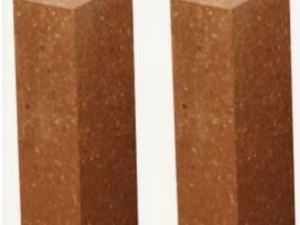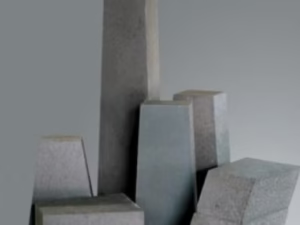Description
Mullite Refractories: A Cornerstone of High-Temperature Industries
Mullite refractories are a vital class of materials used in a wide range of high-temperature industrial applications, valued for their exceptional thermomechanical properties and chemical inertness. From furnace linings to kiln furniture, these materials play a crucial role in processes that demand reliable performance under extreme conditions.
What is Mullite?
Mullite is an aluminum silicate mineral with the chemical formula Al6Si2O13 (3Al2O3·2SiO2). It’s relatively rare in nature, primarily found in metamorphic rocks formed under high temperature and low pressure. However, commercially, mullite is manufactured through the high-temperature reaction of alumina (Al2O3) and silica (SiO2).
Key Properties of Mullite Refractories:
The superior performance of mullite refractories stems from a unique combination of properties, including:
- High Melting Point: Mullite has a melting point around 1850°C (3362°F), allowing it to withstand extremely high temperatures without deformation or degradation.
- Excellent Thermal Shock Resistance: Mullite exhibits low thermal expansion and high thermal conductivity, making it resistant to cracking or spalling when subjected to rapid temperature changes. This is crucial for applications where temperature fluctuations are common.
- High Creep Resistance: Under sustained high temperatures, mullite resists deformation over time, maintaining its structural integrity and preventing sagging or creep.
- Good Chemical Inertness: Mullite is highly resistant to attack by many corrosive agents, including acids, alkalis, and molten metals, making it suitable for use in chemically aggressive environments.
- High Mechanical Strength: Mullite refractories possess good compressive and flexural strength, ensuring they can withstand mechanical loads at elevated temperatures.
- Low Thermal Conductivity (relatively): While having high thermal conductivity compared to some other refractories, it is relatively low compared to metals, making it effective in insulating against heat loss.
Manufacturing Mullite Refractories:
The manufacturing process involves several key steps:
- Raw Material Selection: High-quality alumina and silica sources are chosen based on their purity and particle size distribution. Common raw materials include calcined alumina, sillimanite, kyanite, and andalusite.
- Mixing and Grinding: The raw materials are thoroughly mixed and ground to achieve a homogeneous mixture and the desired particle size.
- Shaping: The mixture is shaped into the desired form using various methods, including pressing, casting, and extrusion.
- Firing: The shaped products are then subjected to high-temperature firing (sintering) in a kiln. During firing, the alumina and silica react to form mullite crystals, which bind the refractory together.
- Cooling and Finishing: After firing, the refractories are cooled gradually to prevent cracking. Finishing processes may include grinding, cutting, or surface treatment to meet specific application requirements.
Applications of Mullite Refractories:
The exceptional properties of mullite refractories make them indispensable in a wide variety of industries:
- Ceramics Industry: Kiln furniture, such as shelves, saggers, and supports, used for firing ceramic products.
- Glass Industry: Linings for glass melting furnaces, regenerators, and feeders.
- Metallurgy Industry: Linings for blast furnaces, steel ladles, and other high-temperature vessels used in metal processing.
- Cement Industry: Linings for rotary kilns and other equipment used in cement production.
- Petrochemical Industry: Insulating materials and linings for cracking furnaces and other high-temperature reactors.
- Power Generation: Linings for incinerators and other combustion equipment.
- Aerospace: Components for high-temperature applications, such as rocket nozzles and heat shields.
Different Types of Mullite Refractories:
Mullite refractories can be classified based on their alumina content and manufacturing method. Common types include:
- Low-Alumina Mullite Refractories: Contain a relatively lower percentage of alumina and are typically less expensive.
- High-Alumina Mullite Refractories: Offer superior high-temperature performance and chemical resistance due to their higher alumina content.
- Fused Mullite Refractories: Made by melting a mixture of alumina and silica and then solidifying it. These refractories have a very dense microstructure and excellent corrosion resistance.
- Bonded Mullite Refractories: Bonded with various materials, such as clay or phosphate, to improve their strength and other properties.
Future Trends:
Ongoing research and development efforts are focused on improving the properties of mullite refractories and expanding their applications. Key areas of focus include:
- Developing new manufacturing techniques to produce refractories with improved microstructure and performance.
- Incorporating additives and reinforcements to enhance the strength, thermal shock resistance, and corrosion resistance of mullite refractories.
- Exploring the use of novel raw materials to reduce costs and improve the environmental sustainability of manufacturing processes.
- Developing tailored mullite refractories for specific applications with demanding performance requirements.
Conclusion:
Mullite refractories are essential materials for a wide range of high-temperature industrial processes. Their exceptional thermomechanical properties and chemical inertness make them ideally suited for demanding applications where reliability and performance are critical. As industries continue to push the boundaries of high-temperature processing, the demand for advanced mullite refractories will continue to grow, driving innovation and development in this important field.












Reviews
There are no reviews yet.